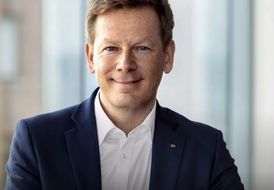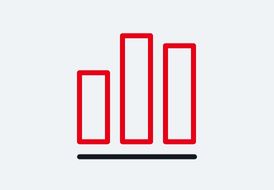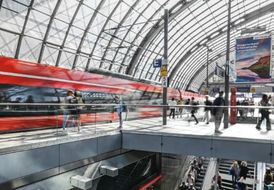Development of the infrastructure
In 2022, we made capital expenditures in infrastructure for the construction and renewal of the network, stations and energy facilities amounting to € 10.7 billion. In addition, € 2.5 billion was spent on maintenance from DB funds. The negative impact of increases in the prices of materials and material bottlenecks on ongoing construction projects was limited by effective crisis management and close coordination with the construction industry. In many cases, close monitoring and targeted countermeasures enabled us to resolve any disruptions that occurred quickly in cooperation with the construction industry.
Two major projects went into operation in December 2022:
- New construction line Wendlingen — Ulm: With the commissioning of the new construction line as part of the Stuttgart — Ulm rail project, travel times for long-distance transport between Stuttgart and Ulm were reduced by about 15 minutes three years before the commissioning of the project as a whole. In regional transport, for the first time the new Merklingen station will be served every hour on the new construction line. The new construction line is equipped with the European train control system ETCS. A milestone was also reached at the Stuttgart hub: in early October 2022, the project for the seven railway tunnels in the Stuttgart valley was completed. A total of 51 km of tunnels have been built in recent years.
- Railway connection to Jade-Weser-Port: The rail connection to Germany’s Jade-Weser-Port also went into operation in December 2022. The double-track, electrified Oldenburg — Wilhelmshaven line provides a high-performance connection between the port and the national and European rail network. To this end, the undersoil of the line was extensively upgraded and the line was continuously expanded to run on two tracks and electrified. A 44.5 km noise barrier lowers the rail transport noise for residents.
An additional focus in 2022 was the repair of the damage caused in North Rhine-Westphalia and Rhineland-Palatinate by flooding in 2021. Most of the lines are already back in operation. In June 2022, just under one year after the flood, a financing agreement was concluded with the states of North Rhine-Westphalia and Rhineland-Palatinate to electrify the lines in the Ahrtal and the Eifel region.
Other milestones in the expansion and renewal of the rail network in 2022 included:
- Hamburg hub: In January 2022, a second eastern bypass track near Maschen was put into operation in the Hamburg hub. The railway line is one of the most important connections for Hamburg’s seaports. The second eastern bypass track at Maschen is one of numerous measures to clear the bottlenecks at the Hamburg railway hub and to make it more efficient in the future.
- Four-track expansion between Bamberg and Ebensfeld: In April 2022, one year earlier than planned, the four-track expansion between Bamberg and Ebensfeld (Hallstadt — Breitengüßbach expansion) on the Nuremberg — Erfurt expansion line/new construction line (German unification transport project (VDE) no. 8.1) was completed. This means that separate tracks for high-speed transport and regional and freight transport are available to the north of Bamberg. The new dual-track line heading toward Erfurt/Leipzig/Berlin and the dual-track line heading toward Lichtenfels/Saalfeld/Jena split at Ebensfeld.
- Fulda — Würzburg line renewal: Between June and December 2022, the next stage for the renewal of the Hanover — Würzburg high-speed line was completed with the line renewal in the Fulda — Würzburg section.
- Gäubahn: The two-track expansion of the Horb — Neckarhausen section on the Stuttgart-Singen — Germany/Switzerland border (Gäubahn) expansion line commenced in June 2022.
Construction began in 2022 | |
Project name | Project description |
Stuttgart-Singen — border between Germany/Switzerland (Gäubahn) expansion line |
|
Lines affected by flooding |
|
Cologne hub |
|
Knappenrode — Horka expansion line |
|
Munich S-Bahn (metro) (Erding Ring Closure) |
|
Commissioned in 2022 | |
Project name | Project description |
Nuremberg — Erfurt expansion/new construction line (German unification transport project no. 8.1) |
|
Hamburg hub |
|
Oldenburg — Wilhelmshaven expansion line |
|
Wendlingen — Ulm new construction line |
|
Berlin — Dresden expansion line |
|
In addition, in 2022, the following requirement plan and Municipal Transport Financing Act (Gemeindeverkehrsfinanzierungsgesetz; GVFG) projects were under construction:
Projects under construction in 2022 | |
Project name | Project description |
Stelle — Lüneburg expansion line |
|
Nürnberg — Erfurt expansion/new construction line (German unification transport project no. 8.1) |
|
Leipzig — Dresden expansion line (German unification transport project no. 9) |
|
Karlsruhe — Stuttgart — Nuremberg — Leipzig/Dresden expansion line |
|
Ludwigshafen — Saarbrücken expansion line |
|
Stuttgart — Ulm — Augsburg expansion/new construction line |
|
Karlsruhe — Offenburg — Freiburg — Basel expansion/new construction line (1st and 2nd construction phase) |
|
Amsterdam — German/Dutch border — Emmerich — Oberhausen expansion line |
|
Frankfurt am Main hub |
|
Berlin hub (Dresdner Bahn) |
|
Combined transport |
|
Hanau — Würzburg/Fulda — Erfurt expansion/new construction line |
|
Rhine-Ruhr-Express |
|
Angermünde — Szczecin expansion line |
|
Uelzen — Stendal — Magdeburg — Halle expansion line (East Corridor North) |
|
740 m network |
|
Weddel loop |
|
Hamburg hub |
|
Cologne — Aachen expansion line |
|
Rhine-Main S-Bahn (metro) |
|
High-speed regional rail traffic Rhine-Neckar |
|
Nuremberg S-Bahn (metro) |
|
Munich S-Bahn (metro) |
|
Berlin S-Bahn (metro) |
|
At the end of 2022, a total of 203 requirement plan and Municipal Transport Financing Act projects were in planning and under construction. Further information on the projects is available on the BauInfoPortal Web site.


